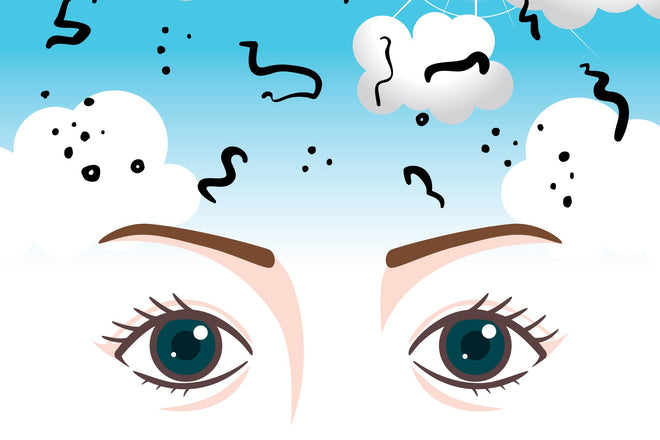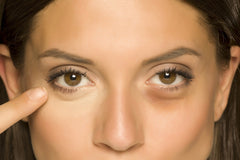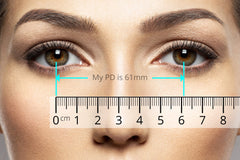When I’m doing the history section of a patient’s eye exam, one of the most common questions I ask is if they have seen floaters recently. And most of my patients answer “yes,” I have noticed floaters.
Seeing floaters in the eye is very common these days, and a lot of people have questions regarding them, especially whether they are dangerous or not. So, I wanted to talk about this topic in detail so I can help answer all your most common questions and concerns regarding floaters.
What are Eye Floaters?
Eye floaters are tiny visual disturbances that appear in your field of view intermittently throughout the day. Types of eye floaters include black or gray specks, strings, webs, or transparent blobs. Even though most floaters are tiny and only cause a mild distraction to your eyesight, occasionally, there may be a large floater that causes a central black spot in your vision.
Since the floaters are inside your eye, they tend to move when you shift your gaze from one direction to another.
It’s important to note that seeing floaters in your eyes should not cause any pain or discomfort—they’re just visual disturbances that go away eventually.
What Causes Eye Floaters?
The most common cause of floaters is the aging process. The back of the eye is composed of a jelly-like substance called vitreous humor, and as we age, it liquifies and clumps together as debris. Light travels from outside the eye through to the back of the eye, and this incoming light passes through and hits the floater, causing us to detect its presence.
Other causes of floaters include:
- Eye Trauma: If the eye gets hit or is damaged, this will affect the vitreous and may cause even more debris to be produced.
- Myopia: Nearsighted people have a longer eyeball, which may cause the vitreous to stretch more and produce more floaters.
- Retinal Disease: Diseases that cause inflammation like diabetic retinopathy, macular edema, and lupus can cause an increased amount of floating spots.
- Deposits: Deposits in the back of the eye, like cholesterol, will cause an increased sensation of floaters.
- Ocular Migraines: This is a unique kind of migraine where flashes and floaters are experienced without a headache.
- Eye Tumors: Tumors that impact the eye are relatively rare, but when it happens, cancer affects the vitreous humor, and more floaters are produced.
As you can see, there are many causes of floaters, so it is a good idea to have them checked out by an eye care practitioner to make sure there’s no underlying disease or danger to your eyes.
How to Get Rid of Eye Floaters
Eye floaters are not usually sight-threatening unless there is a retinal or neurological reason for them. If it’s just age-related, eye floaters treatment can be as simple as just ignoring them. Over time, the brain adapts to the floaters and erases them from your awareness.
But, if floaters impair your vision and are so large that they are a constant bother to your day-to-day life, then there are medical treatments available to resolve them.
How to Treat Eye Floaters
The first medical option to treating eye floaters is through a vitrectomy. This is a somewhat risky surgery where the floaters are removed from your line of sight by physically removing the vitreous via a small incision. The vitreous is a gel-like substance that keeps the shape of the eye round.
The retinal surgeon will replace the vitreous with a solution that maintains the shape of the eye, and eventually, the eye will replace the solution with natural vitreous.
Vitrectomy is not often performed because of the potential risks, such as surgery-induced retinal detachments, bleeding, trauma, and loss of vision. So, it is only performed under extreme situations.
A second option to getting rid of eye floaters is a laser therapy called Laser Vitreolysis. It is much safer than a vitrectomy since it’s not invasive and doesn’t require surgery. It’s an in-office procedure where a laser beam is directed through the eye at the floater inside the vitreous. This procedure breaks the floaters apart and dissolves them.
With both medical options, it’s always a good idea to make an appointment with a retinal specialist to figure out which choice is right for you and your situation. There is no guarantee of success with either procedure, so it’s necessary to weigh your options.
How to Get Rid of Eye Floaters Naturally
For most people, the thought of surgery or medical treatment is unappealing as a way to treat annoying eye floaters. Fortunately, eye floaters can be managed naturally in several ways.
Since there is no natural treatment available that can dissolve them, the most common way eye floaters are “cured” naturally is to leave them alone. The force of gravity will push them to the bottom of your eye, out of your line of sight, which will cause them to disappear. Also, the brain will ignore some floaters that remain in your line of sight by simply erasing them from your conscious awareness.
Other preventions include eye exercises, use of sunglasses, herbs, oils, and supplements. These natural solutions help improve the overall health of the eyes by providing antioxidants, minerals, and vitamins, as well as improving the overall health of the body. The downside is that it is trial and error to see which combination of treatments will yield the best result for each individual person.
Eye Drops for Floaters
If you search the internet, eye floaters treatment drops can be found on many different sites, promising relief from floaters. However, most are not FDA approved and cannot back up their claims by proper medical testing.
Logically, if you think about where the floaters are located, which is deep in the vitreous inside the eye, the drops (which only impact the surface of the eye) cannot reach them. So, it’s doubtful that drops would help get rid of floaters.
When to See Your Eye Care Professional
For the most part, floaters are a harmless annoyance that most people experience at least once in their life. Since floaters are age-related, the occurrence of floaters increases as we age. Eventually, they vanish from our line of sight, due to the force of gravity. Or, we just ignore them, and they eventually disappear from our awareness.
There are medical options available for those floaters that occur suddenly or are so big that they pose a threat to our vision. But, floaters can also be a sign of a much more dangerous retinal problem like retinal detachment, diabetic retinopathy, or macular edema.
In those situations, it is essential to go to an eye care practitioner immediately to make sure it’s not dangerous and to receive the proper medical treatment. And, if you’re experiencing other symptoms like pain and discomfort—or, if you’re just not sure and want to be on the safe side—go ahead and see your practitioner as soon as possible.





